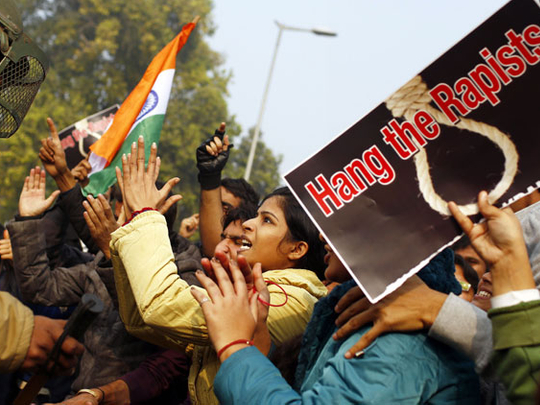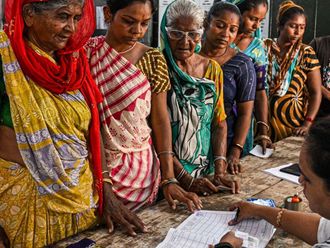
I was there in Delhi on December 16, when the savage rape and battery of the 23-year-old student of physiotherapy by a gang of cowardly criminals took place on a moving bus. The whole country was absolutely shocked by the wanton brutality of that barbaric act. A week later, huge crowds were marching in the streets of Delhi, demanding justice and major changes in the criminal code, to prevent any repetition.
We know that such changes are essential when we learn that the conviction rate for rape cases is only 26 per cent, down from 46 per cent the previous year, that there is a long backlog of 40,000 pending trials and that suspects roam the streets on bail. There are apparently 65,000 police officers in Delhi, but 20,000 of them are too busy providing protection for politicians and VIPs! Even more alarming is the impunity of police officers when they, themselves, commit rape and theft, which seems to be common knowledge in India, and when they fail to investigate reported complaints or perform timely forensic tests and when some dismiss reported cases with remarks like “she was dressed for rape”, referring to the victims!
It reminded me of a statement by a very senior minister in Yemen a few years ago. When he heard that European women were regularly “touched” at the Salt Market in Sana’a, he said, in my presence: “Well if they dress like that, they deserve to be molested!” It also reminds me of the story published on March 6, 2007, about a Saudi woman who was kidnapped at knifepoint, gang-raped and then beaten by her brother, subjecting her to 90 lashes — for meeting a man who was not a relative. However, what could be more horrendous than the story of the Somali 13-year-old girl, stoned to death by militants after she had been accused of “adultery”. Reports indicate that she had been raped by three men while travelling on foot to visit her grandmother in the war-torn capital, Mogadishu.
The Delhi incident invites comparison with other countries. Apparently, South Africa “is the rape country of the world”! According to an article by Roni Caryn Rabin, published on December 14, 2011, 1.3 million American women annually may be victims of rape or attempted rape, i.e. around 1 per cent of American women. According to Eleanor J Bader, in an article published on December 21, 2012, women prisoners endure rampant sexual violence. What is less known is that between 1 and 2 per cent of males have been raped, many when they were younger than 11.
An interview by Al Jazeera of an Indian female reporter on December 23, indicates that rape occurs every 20 minutes in India, i.e. 72/day or 26,000/year. The comparative figure for the US is 85,000/year. However, the population of the US is only a quarter of that of India!
The Times of India published practical steps to make women safe — including harsher punishment such as chemical castration. Death penalty was mentioned, but it was also pointed out that rapists may then kill their victims to snuff out evidence. Fast tracking the slow court system, better surveillance and gender sensitisation of the police were listed, in addition to public and especially police education. However, while these are important and necessary steps, the problem cannot wait another two decades while they begin to work and while another half a million women are raped and brutalised.
But why has the government unleashed its own violent suppression of peaceful protest? Apparently, it is because of Section 144 of the criminal code which deals with demonstrations, in this ostensibly democratic country! We have seen the police using long, heavy, truncheons on peaceful unarmed demonstrators on TV, most of whom were female. There seems to be a major disconnect between economic progress and human rights in India, judging by what is happening today. I watched Prime Minister Manmohan Singh promising to form yet another advisory committee, but in the same breath, condemning violence. The only violence I saw on TV screens was by the Delhi Police and the medical testimony seems to confirm the dead policeman did not suffer any injury.
As those huge demonstrations fizzled out, another rape victim took her own life, leaving a note indicating that the police did not act on her complaint for three weeks, which confirms that the main cause of the problem is police incompetence and apathy in applying existing laws. One placard caught my eye, which said: “Prime Minister, what if this was YOUR daughter?”
In an interview on Al Jazeera TV, an Indian woman said: “We are only here to express our outrage at this rape and to make sure that the perpetrators are so severely punished that no one will ever think of committing such a crime ever again.” Another statement was: “The government is wrong if it thinks that the youth of today will be intimidated by the actions of the security forces. Today, India is a new country.”
It would seem, therefore, that the fear which ordinary citizens used to harbour in the Middle East, and in India, has now evaporated and they will not rest until change does occur and justice is seen to be done. Sadly, whatever changes do occur, it is too late for this victim who died in Singapore last Friday.
Dr Qais Ghanem is a retired neurologist, radio show host, poet and novelist. His two novels are Final Flight from Sana’a and Two Boys from Aden College. His non-fiction, My Arab Spring, My Canada, was published by Amazon.









